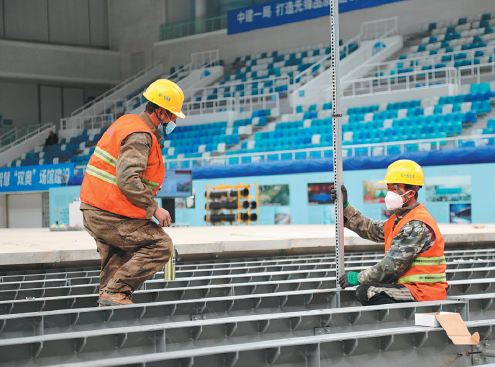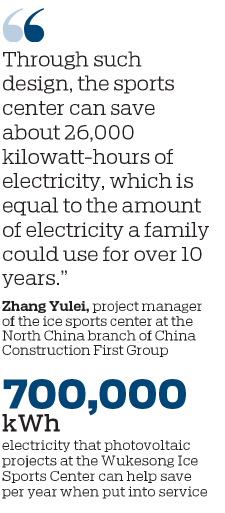China Construction First Group gives 2022 Winter Games projects green, clean touch

Compared with traditional blueprints, the one for the athletes village for the Beijing 2022 Olympic and Paralympic Winter Games appears distinct because it has several special marks that highlight environment protection efforts.
The athletes village, located at the foot of the Xiaohaituo Mountain in Yanqing district of Beijing, has completed construction by the end of 2020.
Xie Qichao, project manager for the athletes village from a unit under China Construction First Group Corp Ltd, the firm tasked with construction of the village, said: "We marked out locations of trees and animals that need to be protected and preserved during the construction. Before the construction began, we made a comprehensive survey of different species of trees in the area, and gathered data in terms of their numbers and precise locations.
"Later, we covered those trees with suitable protective nets and undertook watering and fertilizing, and controlled insect infestation during the construction.
"For trees that can't be preserved on-site during the construction, we transplanted them whole at a special plot for protection. Once the construction finished, those trees were replanted at their original sites," he said.
The construction team also set up many wood cabins for squirrels, pheasants and wild birds in the area. The village will be renovated into a tourist resort after the Olympic Games conclude, the company said.
During the construction, the company protected 313 trees and numerous wildlife.
Such biodiversity and wildlife conservation activities are part of China Construction First Group's concerted efforts to protect environment during the construction of various projects for the 2022 Games.
One of the company's projects is for the renovation of National Aquatics Center. China Construction First Group has been sticking to the rule of environment protection and made efforts in energy reservation.
According to the company, in order to convert the National Aquatics Center into a multi-functional sports center for ice-based games during the Winter Olympics, the construction team first dried up the swimming pool, and then set up a curling sheet above the pool. The sheet is easy to set up and remove. The goal was to lift up the usage rate of existing sport centers to create new functions to achieve sustainable development.
"We also equipped the roof with a transparent glass-made patio whose diameter is 13 meters long. There are 19 light transmission pipes on the ground. The goal is to allow sunlight, or through reflection, into the sport center for lighting purposes and save on electricity costs to preserve energy," said Zhang Yulei, project manager of the ice sports center at the North China branch of China Construction First Group.
"Through such design, the sports center can save about 26,000 kilowatt-hours of electricity, which is equal to the amount of electricity a family could use for over 10 years,"Zhang said.
China Construction First Group also leveraged technical strengths to conduct environmentally friendly and energy-efficient construction.
The Wukesong Ice Sports Center has become the first stadium in China to adopt a carbon dioxide-based ice-making system. As a natural refrigerant, carbon dioxide-based ice-making is environmentally friendly and efficient in cooling performance.
Carbon dioxide-based ice-making also has high cooling capacity per unit volume, good thermal conductivity and will not cause damage to the ozone layer.
The heat, produced in the process of ice-making, can be recycled for other purposes such as heating water in the bathrooms. Compared with conventional refrigerants, carbon dioxide-based ice-making can increase the energy efficiency by 40 percent, according to China Construction First Group.
Feng Yanjun, project manager of the Wukesong Ice Sports Center of China Construction First Group Construction & Development Co Ltd, the subsidiary executing the project, said the center has ultra-low energy consumption. The project uses transparent curtain walls and roof patio to allow natural light to filter into the center for lighting purposes.
The center also installed photovoltaic projects, which will save 700,000 kWh of electricity per year when put into operation.
China Construction First Group's efforts to preserve wildlife, promote low-energy consumption, and protect the environment are aligned with the guidelines of the Beijing Organizing Committee for the 2022 Olympic and Paralympic Winter Games, which call for using renewable energy resources for electricity consumption and constructing low-carbon and energy-efficient sports centers.
"The committee's promotion of low-energy consumption and environmental protection in constructions of projects is likely to guide the market of sports centers, especially those for recreational purposes and open to public, toward greener construction and use. At present, green construction of sports centers is becoming a trend," said He Wenyi, secretary-general of Peking University's China Institute for Sports Value.
"The move to renovate athletes village into a tourism resort, and to convert the National Aquatics Center into a multi-functional sports center, is also important for the sustainable development of the market. Going forward, it is important to figure out post-Games uses of those sports centers. Since the 2022 events will attract a wide range of enthusiastic fans and audiences, it's likely that those sports centers will become public spots for tourism and recreational exercising, which will open bigger markets with more business opportunities," He said.
Huang Xinyi, a Beijing resident who lives close to the National Aquatics Center, said she swims at the center during summers as the center is open to the public. "The facilities are much better compared with swimming pools in the integrated gym that I used to go to, but the prices are relatively the same. If more centers open to the public after the 2022 Games, I'll definitely go."
liuyukun@chinadaily.com.cn























